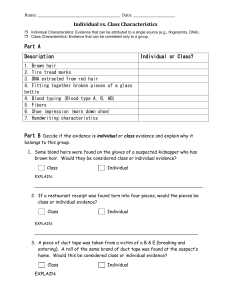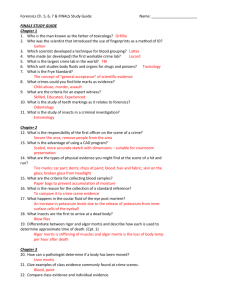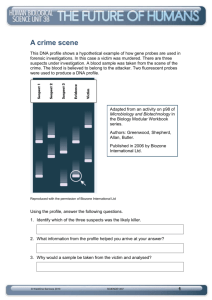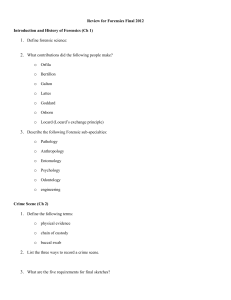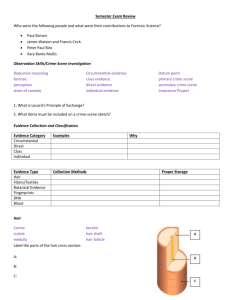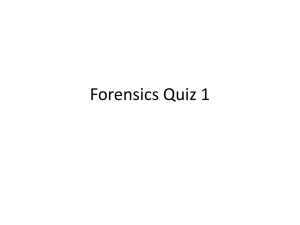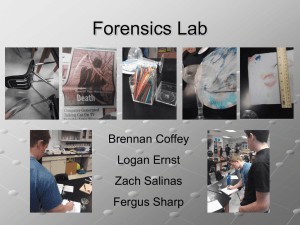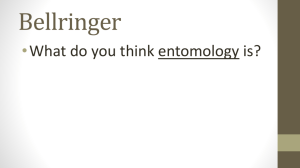What you will need to know/ be able to do on the June 2014
advertisement
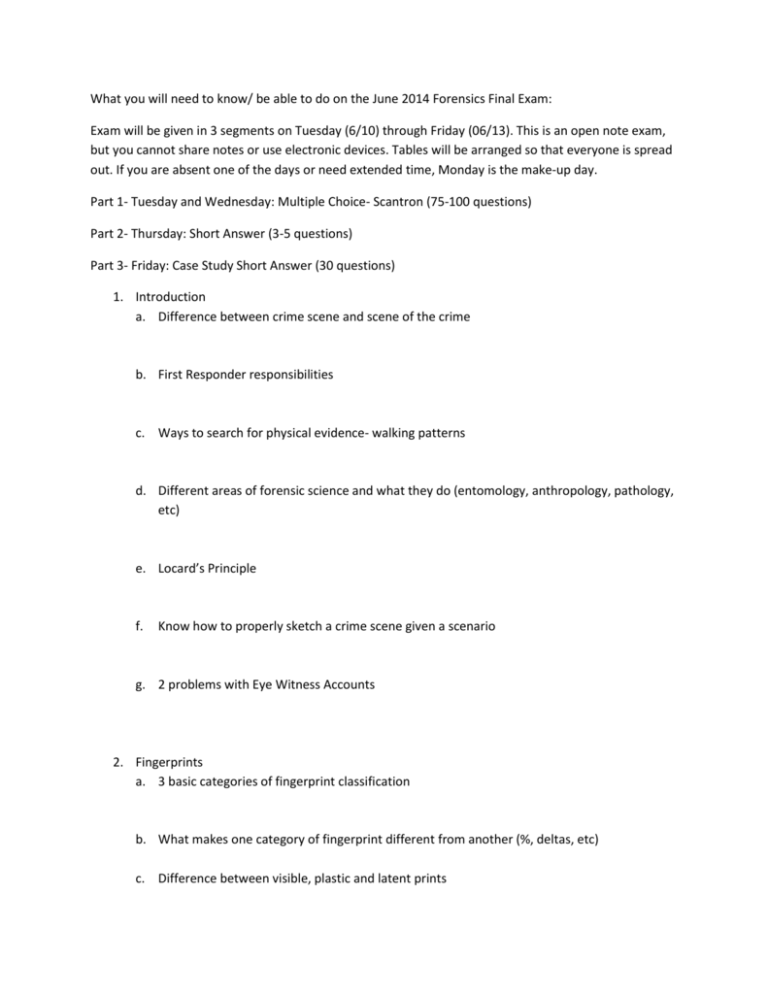
What you will need to know/ be able to do on the June 2014 Forensics Final Exam: Exam will be given in 3 segments on Tuesday (6/10) through Friday (06/13). This is an open note exam, but you cannot share notes or use electronic devices. Tables will be arranged so that everyone is spread out. If you are absent one of the days or need extended time, Monday is the make-up day. Part 1- Tuesday and Wednesday: Multiple Choice- Scantron (75-100 questions) Part 2- Thursday: Short Answer (3-5 questions) Part 3- Friday: Case Study Short Answer (30 questions) 1. Introduction a. Difference between crime scene and scene of the crime b. First Responder responsibilities c. Ways to search for physical evidence- walking patterns d. Different areas of forensic science and what they do (entomology, anthropology, pathology, etc) e. Locard’s Principle f. Know how to properly sketch a crime scene given a scenario g. 2 problems with Eye Witness Accounts 2. Fingerprints a. 3 basic categories of fingerprint classification b. What makes one category of fingerprint different from another (%, deltas, etc) c. Difference between visible, plastic and latent prints d. Be able to use Henry Classification System and Formula given directions e. Methods for developing latent prints (iodine fuming, ninhydrin, silver nitrate, etc) 3. Hair and Fiber: a. Differences between cut with scissors and cut with razor b. Differences between naturally shed, pulled and broken, pulled with tissue attached c. What creates the shape of synthetic fibers d. 6 characteristics that can be determined from hair e. 3 basic patterns of cuticles f. What shapes cause hair to appear kinky, straight or curly g. DNA from hair (mitochondrial vs. nuclear) h. Rate of hair growth 4. Handwriting Analysis: a. Examples of documents that may be questioned b. Characteristics of Handwriting (placement, size, slant, loops, line quality, etc)- be able to distinguish c. Define Chromatography d. Be able to tell a forged document or match up ransom notes 5. Profiling: a. Organized vs. Disorganized b. Types of offenders who are profiled (terrorists, arsonists, etc) c. Criminal profiling vs. Geographical profiling 6. Blood Patterns a. Blood Types b. Compatible/Incompatible blood types (for blood transfusions, etc) c. Speed of impact based on spatter d. Blood drops from standing still vs. running e. Which direction the tail points in? f. Angle of impact (given formula- will need to solve) 7. DNA a. What does it stand for b. Be able to label a diagram c. Be able to list the bases and how they pair d. Steps for testing DNA e. Be able to break up DNA (line after TT if there is a GG after it) and count fragments to match a DNA sample to a suspect 8. Time of Death a. Aspects studied, including definitions (lividity, rigor mortis, algor mortis, etc) b. Factors that affect algor mortis and how they affect cooling c. What stomach contents may prove and how long food will stay in stomach d. Which factors to use when based on time that has passed 9. Entomology a. Life cycle of the blow fly b. What effects the rate of development of blow flies c. Which bugs arrive when 10. Anthropology a. General characteristics of Male vs. Female bone structure b. Using long bones to determine height c. Unique things to look for when examining bones 11. Ballistics a. Marks left on a bullet by the gun use of identification b. Testing bullets 12. Toxicology a. True poison vs. Intoxicant b. Signs of exposure to certain poisons (ie. Organs bright cherry red from carbon monoxide) c. Procedure for testing for toxins 13. Odontology a. Unique characteristics of teeth and what they show (ie. Eating disorder, different practices, professions) b. Determining age from teeth c. Procedure for using odontology in an investigation 14. Impression Evidence- questions will be taken off the last quiz 15. Fire Investigation- Questions will be taken off the last quiz 16. Palynology a. What is it? b. History of use c. Where it is most commonly used d. Why it is used e. What it can prove CASES: Francesca Rojas, Richard Ramirez, Nickell, Ross, Perry, Magnuson, Chase, Duffy, Voirbo, Watkins, Zeigler and Romanovs Thank you for a great year! I hope you learned something from the class. Best of luck on your finals and in all that comes your way!!!! -Ms. Whittaker
